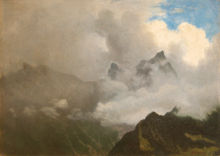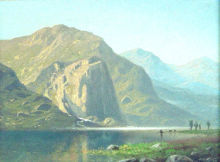Likely the most famous and financially successful late 19th-century painter of the American western landscape, Albert Bierstadt created grandiose, dramatic scenes of the Rocky Mountains and Sierra Nevadas that lured many people to visit those sites. He was also one of the first artists to use a camera to record landscape views.
Bierstadt was born in Solingen, near Dusseldorf, Germany, and sailed as a baby with his family who settled in New Bedford, Massachusetts. Unlike many of his successful peers, as a child, he showed only casual interest in and talent for art, and he had little encouragement from his family. In New Bedford, he acquired a few collectors of his early work including a Mrs. Hathaway from a local shipping family. At a New Bedford Concert Hall, he also used the floral images of George Harvey (1800-1878) for a scenery picture shows with a Drummond Light, a lantern that allowed one picture to fade into another.
In 1853, he returned to Dusseldorf where he studied at the Royal Academy with landscape painters Andreas Aschenbach and Karl Friedman Lessing. Some of his fellow students were Emmanuel Leutze, Sanford Gifford and Worthington Whittredge, and they all learned much attention to detail, respect for composition and skilled drawing. During this period, he traveled extensively in Europe, especially Italy, and companions were Whittredge and Gifford. He completed many picturesque Old World scenes in the style that later became his trademark.
In 1857, he returned to the United States and painted the White Mountains of New Hampshire, and in 1858, exhibited for the first time at the National Academy of Design in New York. His fourteen entries included, Lake Lucerne, which was one of the biggest in the exhibition. That same year, representatives of the Boston Atheneum, purchased his painting, The Portico of Octavia, Rome, for $400.00 and this was the first museum purchase acquisition of his work.
In January 1859, he heard a lecture in New Bedford on the American West by Bayard Taylor, famous traveler and lecturer, and this exposure stirred an interest that played a large part in his future career. Meanwhile, he had settled into New York City where he lived and occupied a studio in the Tenth Street Building, which had 25 studio spaces and became well known for its prestigious occupants. He remained in this studio space until 1881, when he moved to 1271 Broadway to the Rensselaier Building.
A year later he found the subject matter that set the course of his career. He joined a western military expedition led by Colonel Frederick W. Lander to survey wagon routes in the Rocky Mountains and Wyoming. From sketches and artifacts such as buffalo hides and Indian items, he painted studio western scenes including landscapes, Indians, and wildlife in the traditional style he had learned in Europe.
In the 1860s and 70s, he earned the highest prices ever achieved by an American painter, and the US Congress allotted $20,000 for one of his paintings. In 1867, he had a grand tour of Europe and England including a special audience with Queen Victoria. His painting, Among the Sierra Mountains, California, was exhibited at the Royal Academy of London with mixed reactions as some thought it overtaxed the viewers’ minds and imaginations. He received the Chevalier of the Legion of Honor by Napoleon III and the Order of the Stanislaus from the Czar of the Russias.
Bio from askart.com


